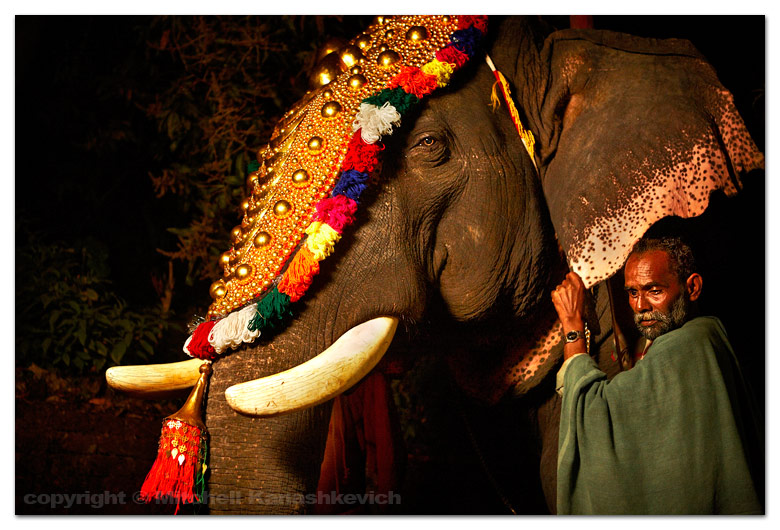 Thrissur - the cultural capital of Kerala, but just where do you begin to look for the culture? The Keralan towns I've come across are nothing like those of North India. The culture is not on display for you, you don't see turbaned men and traditionally dressed women with tribal tattoos walking the streets, as you do in Gujarat and Rajasthan, even in parts of Delhi. You have to dig a little deeper and the government run Thrissur tourist office was where I began digging. Good idea, although the tourism officers could not provide me with any practical information on where to find a festival or see Kathakali, they did direct me to the right person - Mr C.A. Menon, an charismatic, white-bearded gentlemen, somewhat eccentric and passionate about his culture and sharing it with anyone interested. As he sat on his antique reclining chair and I on his antique hanging bed, that used to belong to a Sultan, he spoke with excitement about a festival that was to take place at Guruvayoor, in an ancient Krishna temple 30 km form Thrissur. "This only happens once a year! You are very lucky! There will be elephants and an oracle who will get into a trance and throw colorful powder on himself! This is a ceremony to appease the Goddess Kali! It will be very special!" And so we rode Guruvayoor. The procession was in full swing, deafening music, even more deafening fire crackers, an oracle, who threw all sorts of things on himself - red powder, yellow powder, rice and various vegetables and there were elephants. They swayed from side to side and flapped their ears, looking rather sad and bored by the happenings. When all was finished, we didn't quite know what to make of everything. The next day Mr Menon sent us to see another procession, unfortunately it didn't leave a positive impression on us. The peak of this procession came when five elephants, some as big as a bus reached the temple. A few hundred men, drunk out of their minds, cheered, danced, sang and threw rice (a ritualistic thing) at the beasts. These elephants again swayed and flapped their ears to the mayhem around them, while the mahouts occasionally poked and hit them with thin sticks. I thought that at any minute I could witness a "When animals attack!" moment, but somehow these magnificent creatures kept their cool and didn't stomp on anyone.When I saw Mr Menon again, he asked me what I thought. I didn't have the heart to tell him, so I simply told him that the processions were an amazing spectacle, which they were. The same night Mr Menon gave us the location of a performance of an ancient form of Kathakali - a classical dance, which Kerala is world-famous for. The make-up part and the preparations were even more impressive than those I had witnessed at the Theyyam performances, but, and I don't mean to be an ass and seem like I am winging, after watching Theyaam - the somersaults, the fire-walking and the biting off of chicken heads, the subtle movements of Kathakali almost put me to sleep. Call me ignorant, uncultured, whatever - Kathakali just ain't that exciting. That doesn't mean that it's not photogenic, it is, extremely (which I think the images suggest) but the part behind the scenes is really the only thing that captivated me. Now, my opinions don't mean that what I've seen is not worth seeing, I guess it's just better not to expect any "magic".
Thrissur - the cultural capital of Kerala, but just where do you begin to look for the culture? The Keralan towns I've come across are nothing like those of North India. The culture is not on display for you, you don't see turbaned men and traditionally dressed women with tribal tattoos walking the streets, as you do in Gujarat and Rajasthan, even in parts of Delhi. You have to dig a little deeper and the government run Thrissur tourist office was where I began digging. Good idea, although the tourism officers could not provide me with any practical information on where to find a festival or see Kathakali, they did direct me to the right person - Mr C.A. Menon, an charismatic, white-bearded gentlemen, somewhat eccentric and passionate about his culture and sharing it with anyone interested. As he sat on his antique reclining chair and I on his antique hanging bed, that used to belong to a Sultan, he spoke with excitement about a festival that was to take place at Guruvayoor, in an ancient Krishna temple 30 km form Thrissur. "This only happens once a year! You are very lucky! There will be elephants and an oracle who will get into a trance and throw colorful powder on himself! This is a ceremony to appease the Goddess Kali! It will be very special!" And so we rode Guruvayoor. The procession was in full swing, deafening music, even more deafening fire crackers, an oracle, who threw all sorts of things on himself - red powder, yellow powder, rice and various vegetables and there were elephants. They swayed from side to side and flapped their ears, looking rather sad and bored by the happenings. When all was finished, we didn't quite know what to make of everything. The next day Mr Menon sent us to see another procession, unfortunately it didn't leave a positive impression on us. The peak of this procession came when five elephants, some as big as a bus reached the temple. A few hundred men, drunk out of their minds, cheered, danced, sang and threw rice (a ritualistic thing) at the beasts. These elephants again swayed and flapped their ears to the mayhem around them, while the mahouts occasionally poked and hit them with thin sticks. I thought that at any minute I could witness a "When animals attack!" moment, but somehow these magnificent creatures kept their cool and didn't stomp on anyone.When I saw Mr Menon again, he asked me what I thought. I didn't have the heart to tell him, so I simply told him that the processions were an amazing spectacle, which they were. The same night Mr Menon gave us the location of a performance of an ancient form of Kathakali - a classical dance, which Kerala is world-famous for. The make-up part and the preparations were even more impressive than those I had witnessed at the Theyyam performances, but, and I don't mean to be an ass and seem like I am winging, after watching Theyaam - the somersaults, the fire-walking and the biting off of chicken heads, the subtle movements of Kathakali almost put me to sleep. Call me ignorant, uncultured, whatever - Kathakali just ain't that exciting. That doesn't mean that it's not photogenic, it is, extremely (which I think the images suggest) but the part behind the scenes is really the only thing that captivated me. Now, my opinions don't mean that what I've seen is not worth seeing, I guess it's just better not to expect any "magic".
 The day after the Kathakali we would see another elephant procession. This one would take place at night and could potentially be more colorful and bright than the first two we had seen. It was, and we got to see the elephants getting dressed up for their "big moment". With the fear that the elephant could get pissed off at my dear wife when the flash in a soft-box sets off I asked the mahouts whether it was OK to use our little set-up while photographing, they said it was. We took a few shots, but we were feeling a little down. Tanya in particular wanted to see elephants and get close to them, and now when she did, they were in chains, swaying and flapping their ears, their tiny eyes looking sad and lifeless (perhaps that's just how they look). When the time for the ceremony came, the firecrackers exploded in a very loud collective bang, the music started and the elephants began to sway, feeling like we had seen all that we wanted to see it was time for us to leave.
The day after the Kathakali we would see another elephant procession. This one would take place at night and could potentially be more colorful and bright than the first two we had seen. It was, and we got to see the elephants getting dressed up for their "big moment". With the fear that the elephant could get pissed off at my dear wife when the flash in a soft-box sets off I asked the mahouts whether it was OK to use our little set-up while photographing, they said it was. We took a few shots, but we were feeling a little down. Tanya in particular wanted to see elephants and get close to them, and now when she did, they were in chains, swaying and flapping their ears, their tiny eyes looking sad and lifeless (perhaps that's just how they look). When the time for the ceremony came, the firecrackers exploded in a very loud collective bang, the music started and the elephants began to sway, feeling like we had seen all that we wanted to see it was time for us to leave.

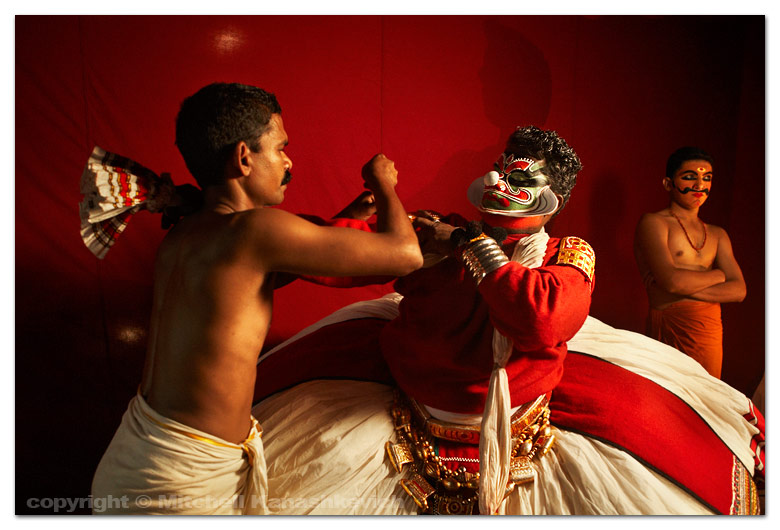 My stay at Thrissur wasn't disappointing, it just wasn't amazing. There was even a bit of "magic" in a place that I discovered accidentally - a Vedic school, in a 500-year-old building. Here thirty children spend most of their days chanting Vedas. From my understanding Vedas are Hindu scriptures that contain all sorts of wisdom. The children that come here belong to a particular cast of Keralan Brahmins, which is responsible for chanting the Vedas, like hymns, during various religious functions. This part of the Hindu culture was on the verge of extinction, but it seems that in the past decade the parents' interest to send their children to the school and spend four years learning how to chant has been renewed. One of the teachers explained: "Eight to twelve is the crucial age, if the Vedas and the way to chant them are imprinted in the boys' minds at this stage of their lives, they will never forget. My Guru learned to chant when he was a young boy like them, then he stopped for fifty years. After retiring he returned to the temple where he learned as a child and with a little practice it all came back to him." The amazing thing is that the chants can last for an entire day and nothing is written down. The words, along with countless tones are memorized, and it has been like that for as long as anyone can remember. It was hard to get any detailed explanation of what the whole purpose of the chanting was, but the scene was otherworldly. The sound of the chanting and the sight of young students in traditional dhotis against the ancient, weathered building made you feel like you are in a totally a different time.
My stay at Thrissur wasn't disappointing, it just wasn't amazing. There was even a bit of "magic" in a place that I discovered accidentally - a Vedic school, in a 500-year-old building. Here thirty children spend most of their days chanting Vedas. From my understanding Vedas are Hindu scriptures that contain all sorts of wisdom. The children that come here belong to a particular cast of Keralan Brahmins, which is responsible for chanting the Vedas, like hymns, during various religious functions. This part of the Hindu culture was on the verge of extinction, but it seems that in the past decade the parents' interest to send their children to the school and spend four years learning how to chant has been renewed. One of the teachers explained: "Eight to twelve is the crucial age, if the Vedas and the way to chant them are imprinted in the boys' minds at this stage of their lives, they will never forget. My Guru learned to chant when he was a young boy like them, then he stopped for fifty years. After retiring he returned to the temple where he learned as a child and with a little practice it all came back to him." The amazing thing is that the chants can last for an entire day and nothing is written down. The words, along with countless tones are memorized, and it has been like that for as long as anyone can remember. It was hard to get any detailed explanation of what the whole purpose of the chanting was, but the scene was otherworldly. The sound of the chanting and the sight of young students in traditional dhotis against the ancient, weathered building made you feel like you are in a totally a different time.
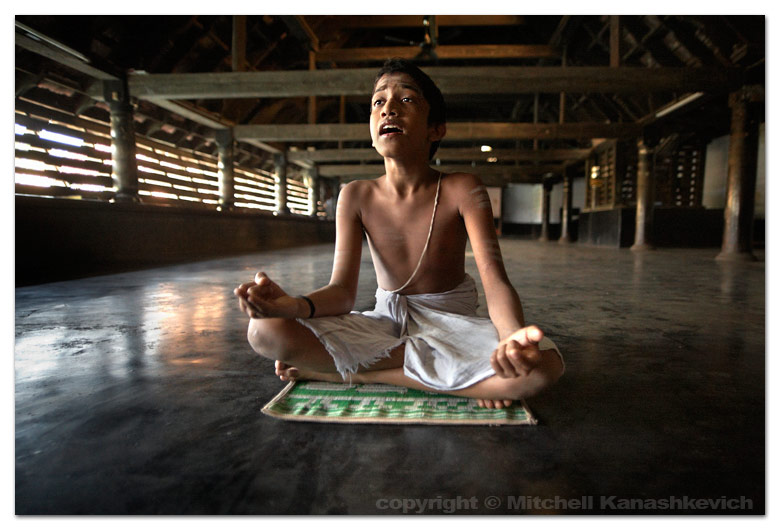
 Photos:
From top to bottom: A temple elephant in his costume and his mahout (elephant carer, trainer). This is one of the images I shot with a flash. Same deal as usual - Tanya holding the flash in a softbox on the side.
A somewhat cliched shot of a Kathakali artist looking in the mirror as he puts on make up. I tried to make this image better than anything I'd seen in the past with the help of the flash set-up. Here, I got Tanya to stand near a light-bulb which was illuminating everything with a yellowish light. We used a gel to warm up the flash and placed it so that the flash light would come from the same direction as the light from the light-bulb.This resulted in matching light which was more intense, thus I could use a lower ISO and a higher shutter speed.
More make-up. Same gel, but the flash is slightly moved away from the light-bulb to illuminate more of the artist's face (in make up).
Last preparations - the Kathakali team is putting the final parts of the costume on the artist. I wanted to have the artist's face illuminated, but I also wanted to have those shadows in the back. The flash was moved to the far left side of the light-bulb. Result - light is coming from both sides, more intense from the left.
A student chanting. He was trying very hard and grimacing all the time.
Bottom: A group of young students chanting.
The chanting images are shot only with the available light, which there was really not much of. I tried a few later with a flash, but this was one of the situations where you either shoot in natural light or have at least two flash units to better simulate this light, otherwise you simply kill the atmosphere.
Photos:
From top to bottom: A temple elephant in his costume and his mahout (elephant carer, trainer). This is one of the images I shot with a flash. Same deal as usual - Tanya holding the flash in a softbox on the side.
A somewhat cliched shot of a Kathakali artist looking in the mirror as he puts on make up. I tried to make this image better than anything I'd seen in the past with the help of the flash set-up. Here, I got Tanya to stand near a light-bulb which was illuminating everything with a yellowish light. We used a gel to warm up the flash and placed it so that the flash light would come from the same direction as the light from the light-bulb.This resulted in matching light which was more intense, thus I could use a lower ISO and a higher shutter speed.
More make-up. Same gel, but the flash is slightly moved away from the light-bulb to illuminate more of the artist's face (in make up).
Last preparations - the Kathakali team is putting the final parts of the costume on the artist. I wanted to have the artist's face illuminated, but I also wanted to have those shadows in the back. The flash was moved to the far left side of the light-bulb. Result - light is coming from both sides, more intense from the left.
A student chanting. He was trying very hard and grimacing all the time.
Bottom: A group of young students chanting.
The chanting images are shot only with the available light, which there was really not much of. I tried a few later with a flash, but this was one of the situations where you either shoot in natural light or have at least two flash units to better simulate this light, otherwise you simply kill the atmosphere.


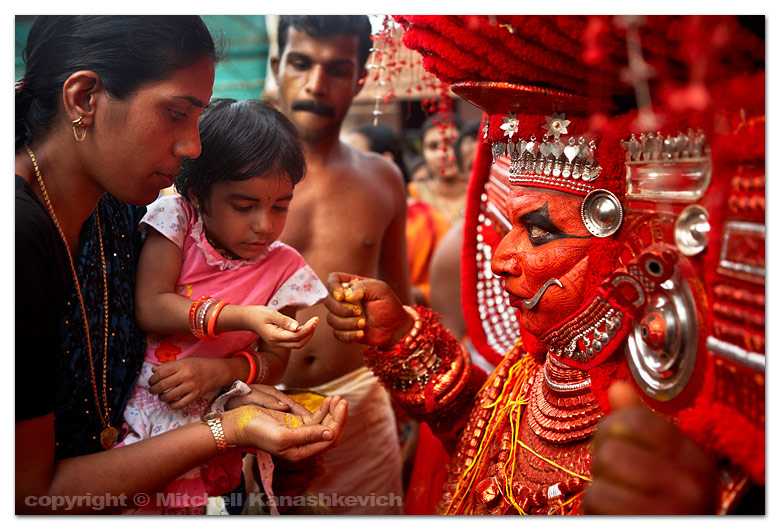 Photographing the Theyyam has been fascinating and frustrating. Fascinating because, well I think the images suggest why, and frustrating for several reasons. First there are crowds and then there are crowds of local photographers who battle for a good angle, not something I'm used to, since I rarely come across 'likeminded individuals' on my photographic quests. The next source of frustration comes from the fact that Theyyam is a deeply religious performance, in fact Theyyam means 'God' in the local language and so while the artist is performing he is basically a deity. When photographing such performances without much knowledge (learning on the spot from the fellow photographers who sometimes get reprimanded for pushing past anyone and anything) one has to tread carefully, not to offend anyone. Of course you could say that I could be better prepared and learn more about what I'm photographing, but not so. I have learned about the principal ideas and the history, however there are more than 400 Theyyam performances which are somewhat different from each other, not only that, the performances take place in different temples all the time and that means that the degree of restrictions is variable. On any given day I do not even know which Theyyam I'll be photographing.
Photographing the Theyyam has been fascinating and frustrating. Fascinating because, well I think the images suggest why, and frustrating for several reasons. First there are crowds and then there are crowds of local photographers who battle for a good angle, not something I'm used to, since I rarely come across 'likeminded individuals' on my photographic quests. The next source of frustration comes from the fact that Theyyam is a deeply religious performance, in fact Theyyam means 'God' in the local language and so while the artist is performing he is basically a deity. When photographing such performances without much knowledge (learning on the spot from the fellow photographers who sometimes get reprimanded for pushing past anyone and anything) one has to tread carefully, not to offend anyone. Of course you could say that I could be better prepared and learn more about what I'm photographing, but not so. I have learned about the principal ideas and the history, however there are more than 400 Theyyam performances which are somewhat different from each other, not only that, the performances take place in different temples all the time and that means that the degree of restrictions is variable. On any given day I do not even know which Theyyam I'll be photographing.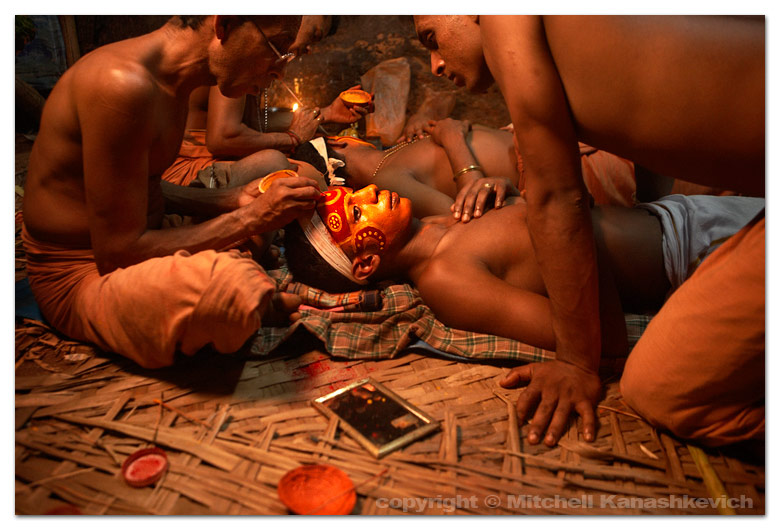
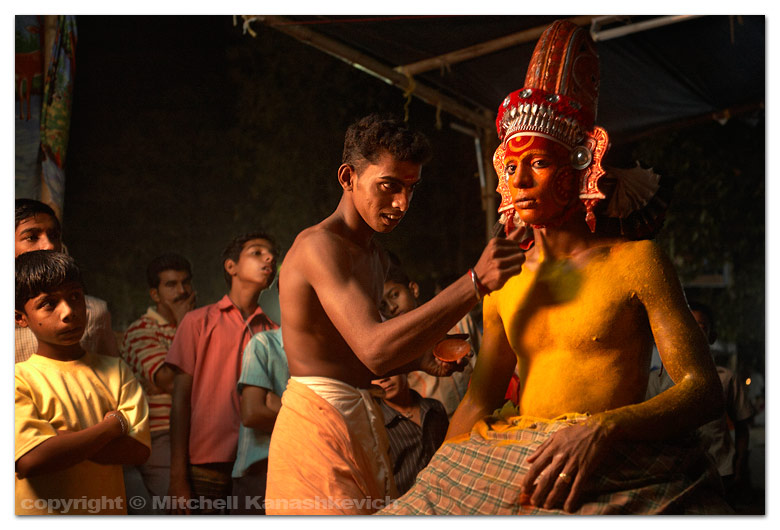 The first Theyyam the "Muhcilot" left me rather unimpressed, performance wise. In short it consisted of an elaborately dressed plump artist circling the temple and murmuring something in what I later found out to be a mixture of Sanskrit, Old Malayalam and Tamil (south Indian languages). Then the devotees rushed in, blessings were given and money started pouring in from all directions, so much money that it had to be put into baskets to be carried away. This went on for over two hours and as I later found out (I couldn't bear staying any longer) it would go into the night, until all of the devotees were blessed.
The first Theyyam the "Muhcilot" left me rather unimpressed, performance wise. In short it consisted of an elaborately dressed plump artist circling the temple and murmuring something in what I later found out to be a mixture of Sanskrit, Old Malayalam and Tamil (south Indian languages). Then the devotees rushed in, blessings were given and money started pouring in from all directions, so much money that it had to be put into baskets to be carried away. This went on for over two hours and as I later found out (I couldn't bear staying any longer) it would go into the night, until all of the devotees were blessed.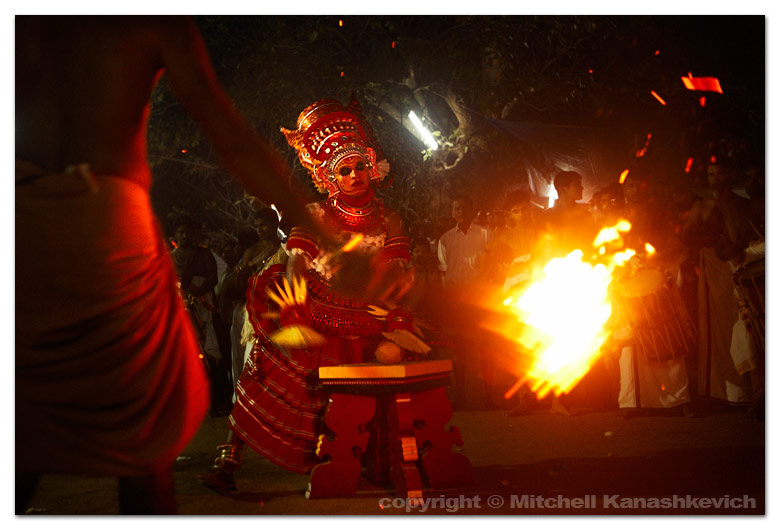
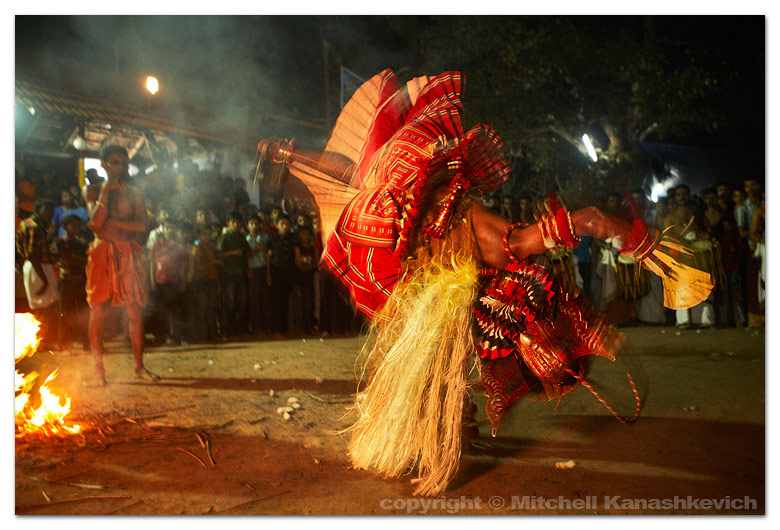 The second Theyyam was the same as the first and rather than watch it I decided to head to the Kerala Folklore Academy, to learn whether there was more to Theyyam than what I had seen. The photos on the walls of their small museum and a very brief conversation with a very-busy-overtime-working Theyyam expert left me with the belief that indeed there was much more to Theyyam. The very next night I would see just how much more. Upon arriving at another village temple I unknowingly befriended a young Theyyam artist who spoke basic English. When I found out who he was and who the small group of young men with him were (all Theyyam artists) I asked if I could photograph them while they put on their makeup and get dressed, they agreed. I photographed the whole process and then, suddenly the temple drummers began to beat a dramatic tune, the last elements of the costume were in place and the artist, as if possessed by a wild beast, jumped from his make up chair and rushed into the temple. His performance would be a stark contrast to the monotonous stuff I had seen earlier. There was fast, loud, dramatic drumming, fire, summersaults and cartwheels. The next Theyyam performance was even more impressive, with more of the same content, executed in an even more dramatic manner. The whole thing was pretty amazing, the atmosphere, the crowd's reaction and of course the Theyyam itself. Tanya and I definitely felt the magic in the air.
The second Theyyam was the same as the first and rather than watch it I decided to head to the Kerala Folklore Academy, to learn whether there was more to Theyyam than what I had seen. The photos on the walls of their small museum and a very brief conversation with a very-busy-overtime-working Theyyam expert left me with the belief that indeed there was much more to Theyyam. The very next night I would see just how much more. Upon arriving at another village temple I unknowingly befriended a young Theyyam artist who spoke basic English. When I found out who he was and who the small group of young men with him were (all Theyyam artists) I asked if I could photograph them while they put on their makeup and get dressed, they agreed. I photographed the whole process and then, suddenly the temple drummers began to beat a dramatic tune, the last elements of the costume were in place and the artist, as if possessed by a wild beast, jumped from his make up chair and rushed into the temple. His performance would be a stark contrast to the monotonous stuff I had seen earlier. There was fast, loud, dramatic drumming, fire, summersaults and cartwheels. The next Theyyam performance was even more impressive, with more of the same content, executed in an even more dramatic manner. The whole thing was pretty amazing, the atmosphere, the crowd's reaction and of course the Theyyam itself. Tanya and I definitely felt the magic in the air.